


 |
November 11, 2014: Isabela Island |
 |
November 9, 2014: From Quito to the Galapagos |
 |
Return to the Index for Our Galapagos Expedition |
Today, we begin our cruise through the Galapagos Islands with our first excursions. We will visit Santiago Island in the morning and Rabida Island in the afternoon.
Morning on the Celebrity Xpedition
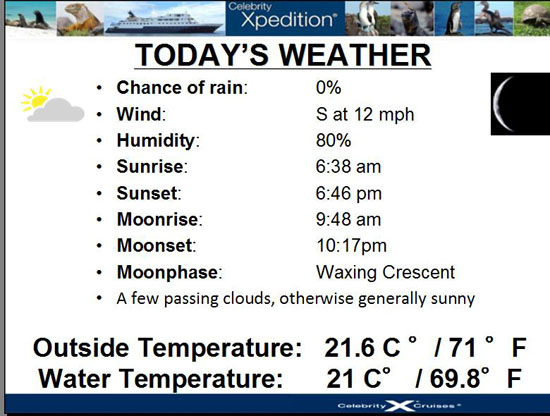 |
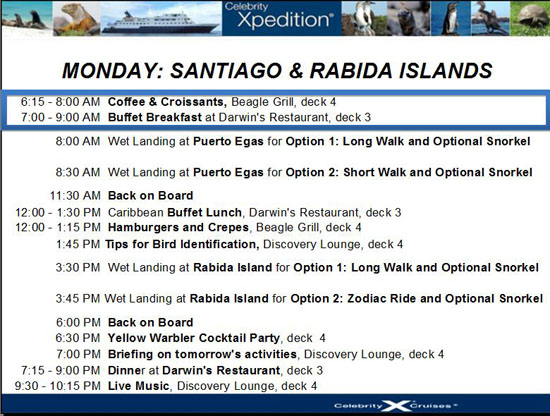 |
It didn't take long for us to develop something of a routine on this cruise. Of course, it was a given that we would go on ever shore excursion that we could- no sense in coming all this way to sit on a boat.
|
It was at these times, that we usually took a few pictures (like the one at left), and so at the beginning of each day, I'll have this little section for any of the interesting pictures we took. For example, click on the thumbnail images below to see the best of today's pictures:

|
Also this morning, I made the first of many panoramic shots that you will see in the pages for this trip. Sometimes, I let the camera itself create the panorama, but other times, like this morning, I took a series of still shots and put them together myself. Here is a panorama of Santiago Island as seen from the Xpedition this morning:
 |
This morning, we also all went to pick out wet suits that fit us and get our snorkeling gear. We'll keep this in labeled bags at the stern, and use the same equipment all week long. We washed it each day we used it, and between boatloads of cruisers the equipment is given a disinfecting rinse and thorough cleaning.
Galapagos Shore Excursion (1):
A Long Walk and Snorkel on Santiago Island
|
| "This excursion will involve a wet landing and then a walk along a sandy, flat trail and a few areas of mostly flat rock. After the walk, swim or snorkel from the beach (if conditions allow)- great for fish and sea turtles. You can also skip the snorkeling and return to the ship after the walk. Duration: Approximately 2-3 hours" |
From the Xpedition to Santiago Island
|
But I think the beach is the right one. As we approached it, I could look back at the Xpedition anchored offshore. In mid-trip, we had frigate birds wheeling around overhead.
As we got right near the beach, we saw our first sea lions sunning themselves on a rock just offshore, and everyone was clicking away (as if these would be only such animals we would see). We'll see lots more later, but click on the thumbnail images below to see our first two pictures of Galapagos sea lions:
 |
I made my first shore excursion movie on our trip into shore. I want to show it to you (although all it shows is our group tooling along in our Zodiac, something we did a lot of during the week.
|
|
On the Beach
|
 |
Puerto Egas, where our Zodiacs landed, is south of James Bay and on the west side of Santiago; it is one of the best sites for wildlife viewing. There is a long, lava shoreline where eroded rock formations house an excellent variety of wildlife. marine iguanas walk along the beach or climb onto the rocks to bask in the sun. The tide pools contain many Sally Lightfoot crabs, which attract other types of hunters. Following the trail, Fur seal lions are found. Puerto Egas is not only a good spot for taking pictures but also perfect for snorkeling and seeing many species of tropical fish.
I took a series of five pictures of our beach landing site and then stitched them together into a panorama. You can have a look at it using the scrollable window below:
A Walk on the Wild Side
|
 |
Walking along the path was interesting, and nearby we could see one of the many extinct volcanoes that are all over the older islands. (Over on Fernandina, the youngest of the island, the volcanoes are much less extinct.) We encountered two denizens of the Galapagos Islands as we walked along the path. One of them was the lava lizard, which is a normal-looking lizard that scurries around in the brush but rarely comes down to the shore.
|
Like all of the mockingbirds found in the Galápagos, this species is long-tailed and relatively long-legged, with a long, slim, decurved beak. It is an omnivore; it eats everything from seeds and invertebrates to eggs, baby turtles and Galápagos sea lion placentas. Research suggests that the species may be an effective distributor of invasive plant species across the islands; it eats more fruit than did several tested species of Darwin's finches, but seeds that pass through its digestive tract generally remain viable. Click on the thumbnail images below to see some other pictures we took of the bird:
 |
We continued along the path until we came to another part of the shore. Along the way, we took some additional pictures that are worth having in the album- including one of a variety of morning glory that is found only in the Galapagos. Click on the thumbnail images below to view these pictures:
 |
Stranger on the Shore
|
I got another nice picture of the Fred with the lava shoreline in the background, and you can see that picture here.
Here, there were numerous interesting rock formations, including natural bridges and blow holes. The natural bridge formations were particularly interesting.
|
Some of the bridges, like the ones at right, were narrow and wet, and crossing them on foot would have been dangerous. But others were relatively high and dry and out guide took us right out onto them. Click on the thumbnail images below for some more good views of these natural bridge formations:
 |
There were many spots along the shore that were photogenic, and one of the things that Fred did was to use his camera's panorama function to make one of the shore; you can see it below:
 |
While I was photographing something in the water, Fred got a good shot of one of these natural canyons, and he also got two other good pictures- one of the shoreline and another one looking inland towards one of the island's volcano cones.
|
|
The best of the blowholes here, however, had a wide opening, and so when the water pushed up through it, it was more like looking into a washing machine than sitting beside Old Faithful.
Use the player at left to watch Fred's movie of this particular blowhole.
We really enjoyed clambering around on the rocky lava flows here, and of course we saw lots of wildlife that we'll get to in a moment. I was happy that the guide didn't rush us along. I ran across an interesting coral-like spiny sea creature, which I think was the source of the little chalky tubules that seemed to be everywhere. I made my own movie of one of the water channels where you can look down into it; you can use the player below, right, to watch that movie.
|
|
Click on the thumbnail images below to see some of the pictures we took of these two sections of the shoreline:

|
Well, those pictures should give you a good idea of what the shoreline here along the walk was like; now let's take a look at what we came to the Galapagos for- the wildlife.
Sea Lions and Fur Seals
|
With a population size of about 50,000, the Galapagos Sea Lion is the second-largest animal found in Galapagos – full-grown males can weigh over 500 pounds. Only the giant tortoises are heavier. Sea Lions are ubiquitous, and their playful, inquisitive behavior means that they are often the first animal that tourists like us encounter; they can often be found sprawled on the docks or benches where tourists board their cruise boats, and are found lounging on beaches or low rocky shorelines throughout the islands. They are a tourist favorite, but they are wild, and we were cautioned to keep our distance.
Sea Lions mainly eat fish that they catch out in the ocean; when on land they congregate in harems (a group of females with one dominant male bull) or in bachelor colonies. Bulls are territorial, defending more an area than the particular female sea lions in it. Conflicts between bulls are quite common. Once a year, females give birth to single pups, which they rear for one to three years. Mothers will stay with their newborn pups for about 5 days, after which pups are left in "nurseries" watched over by a single female and defended by a male. Pups typically learn to fish on their own at the age of five months.
The name "sea lion" is somewhat misleading, as sea lions evolved from the canines rather than the felines, splitting from the bear line after it split from other dogs. All sea lions do make a roaring sound and some actually have a short mane.
|
The population of Galapagos Fur Seals is of similar size to that of the sea lions. Fur Seals typically prefer more rugged, rockier, and shadier shores than sea lions in areas that less likely to be frequented by people. Fur seals are less tolerant of heat than sea lions, which is why they prefer cooler water and shaded areas. And despite their “seal” name, they are actually a type of sea lion.
Fur Seals and Sea Lions have some key physical differences, but these are not always apparent with just a quick glance or even from the wrong angle. Fur seals are generally smaller with broader and shorter heads; they have bulging eyes and ears that protrude more than sea lions’, and larger front flippers that aid in climbing rockier coasts. The biggest difference is probably in their fur coat, which is much thicker and appears “furrier” on fur seals than on sea lions.
Because of their remarkably insulating coats, fur seals were hunted nearly to extinction in the nineteenth century, but they have since made an amazing comeback; Santiago Island is one location where they are most easily seen. Fur seals eat fish and squid, and they are nocturnal hunters. Their social and breeding behaviors are quite similar to that of sea lions, with a few differences. With regards to bulls defending territories, a fur seal bull will defend his harem from land, rather than from the water. Pups begin to hunt at about a year old, but will suckle from their mothers for two to three years. Though females can give birth every year, they will, at most, successfully raise one pup every two years. Should a second pup be born while a yearling is still suckling, the new pup has little chance of survival, despite being defended by its mother.
|
To view the slideshow, just click on the image at right and I will open the slideshow in a new window. In the slideshow, you can use the little arrows in the lower corners of each image to move from one to the next, and the index numbers in the upper left of each image will tell you where you are in the series. When you are finished looking at the pictures, just close the popup window.
Of all the movies we took of the sea lions and fur seals, four of them turned out really well, so I want to include them here.
|
|
In this movie, Fred captured a sea lion getting back into the water from his perch high above one of the rocky water canyons. Apparently, the sea lion dislikes jumping from high places, and he first makes his way down a ways before taking the plunge.
|
|
I was photographing a fur seal when a Sally Lightfoot crab came up onto the rock. The fur seal seemed unconcerned, but perhaps the crab was when he began moving in its direction.
(I eliminated the audio to get rid of the wind noise.)
|
|
Out entire group stopped at one point to watch the antics of a sea lion and her pup. Fred made a movie of them, as did I. As it turned out, his movie ended about where mine began, so you can watch them in sequence.
This is part one of the sequence.
|
|
The second part of the sequence is the movie that I made, and you can use the player at left to watch it.
In the coming days, we will learn more about sea lions and fur seals, but now let's get introduced to another of the famous denizens of the Galapagos Islands.
Marine Iguanas
|
| "The black Lava rocks on the beach are frequented by large, disgusting, clumsy Lizards. They are as black as the porous rocks over which they crawl & seek their prey from the Sea. I call them 'imps of darkness'. They assuredly well become the land they inhabit." |
Marine iguanas forage exclusively on algae in the cold sea, which leads them to behavioral adaptations for thermoregulation. Not withstanding Darwin's writing, Galapagos marine iguanas are not always black; the young have a lighter coloured dorsal stripe, and adult males vary in color with the season- often adding rust-colored patches. Dark tones allow the lizards to rapidly absorb heat to minimize the period of lethargy after emerging from the water.
The marine iguana lacks agility on land but is a graceful swimmer. Its laterally flattened tail and spiky dorsal fins aid in propulsion, while its long, sharp claws allow it to hold onto rocks in strong currents.
Because it forages underwater in the sea, the marine iguana ingests an incredible amount of salt. This should be toxic to them eventually, but in an amazing evolutionary adaptation. A nasal gland filters its blood for excess salt ingested while eating, which is expelled through the nostrils, often leaving white patches of salt on its face. You can see this salt encrustation clearly on the forehead of the iguana shown above.
|
|
Of all the pictures we took of the marine iguanas we saw, I've selected seven more of them to include here. Just click on the thumbnail images below to look at these pictures:

|
To complete this initial look at the Galapagos marine iguana (we will see more of them, and learn more about them, on subsequent shore excursions), I want to include a composite picture I made of one particular iguana. I was able to get quite close to it- so close that I could not get the entire animal in one shot. I took two, and put them together for the view below:
 |
Now for another animal that we saw a great many of here in the Galapagos Islands.
Sally Lightfoot Crabs
|
This crab lives amongst the rocks at the often turbulent, windy shore, just above the limit of the sea spray. It feeds on algae primarily, sometimes sampling other plant matter and dead animals. It is a quick-moving and agile crab, and hard to catch. Not considered very edible by humans, it is used as bait by fishermen.
Grapsus grapsus was collected by Charles Darwin during his voyages on HMS Beagle, and described in detail in the first comprehensive study of the fauna of the Gulf of California, carried out by Ed Ricketts, together with John Steinbeck and others. Steinbeck himself wrote of them:
| "Many people have spoken at length of the Sally Lightfoots. In fact, everyone who has seen them has been delighted with them. The very name they are called by reflects the delight of the name. These little crabs, with brilliant cloisonné carapaces, walk on their tiptoes, They have remarkable eyes and an extremely fast reaction time. In spite of the fact that they swarm on the rocks at the Cape [San Lucas], and to a less degree inside the Gulf [of California], they are exceedingly hard to catch. They seem to be able to run in any of four directions; but more than this, perhaps because of their rapid reaction time, they appear to read the mind of their hunter. They escape the long-handled net, anticipating from what direction it is coming. If you walk slowly, they move slowly ahead of you in droves. If you hurry, they hurry. When you plunge at them, they seem to disappear in a puff of blue smoke—at any rate, they disappear. It is impossible to creep up on them. They are very beautiful, with clear brilliant colors, red and blues and warm browns." |
|
|
We took lots of pictures of these beautiful crustaceans. You can click on the thumbnail images below to see some of them:

|
The Galapagos Brown Pelican
|
 |
Brown Pelicans build their nests in mangrove trees or in low-lying coastal bushes such as salt bushes. Female Brown Pelicans lay two to three eggs and both parents share in incubation and feeding. The Brown Pelican belongs to the family of Pelecaniformes and out of all these species, the Pelican has the largest gular sac, from which the juveniles feed. The Brown Pelicans breed throughout the year, but individual colonies tend to breed around the same time each year. Brown Pelican are successful at raising their offspring, however, unfortunately, many young die from starvation as the Brown Pelican feeding technique is somewhat difficult to learn and many young cannot master it.
The Galapagos Hawk
|
The adult Galapagos Hawk is generally a brownish black color; the crown being slightly blacker than the back. Its chest feathers are usually a buff color, partially edged with paler brown or grey, with their white bases showing to some extent. Their tail coverts are also barred with white. The tail itself is silvery grey above, with about ten narrow black bars; below it is quite pale. The wing feathers are paler on inner webs, barred with white.
|
We came upon this particular hawk from quite a distance, and we were all taking pictures as we approached, never quite knowing when it might take flight. But it never did, even when we got to the eight-foot limit of our approach (as cautioned by our guide). I've selected some of these other photos to include here, and you can click on the thumbnail images below to have a look at them:

|
On our walk, we saw two of the birds that are common in the Galapagos, including the Galapagos mockingbird and the hooded finch.
Snorkeling on Santiago Island
|
It was at this point that I realized that if I ever go on a cruise again where snorkeling is a possibility, I should buy an underwater camera. There were a few people that had them, and I guess they got some good pictures to take home. I gave fleeting thought to putting my own little camera in a Ziploc bag (which I saw one camera owner do, although I think his plastic bag was made specifically for the purpose). I asked him about it, thinking that taking pictures through the bag would make them blurry, but he pointed out that the bag is so close to the lens that the effect of taking a picture through it is negligible.
Anyway, that's why there aren't any further pictures this morning. We had to leave our cameras with the rest of our stuff on the beach, while we went and tried snorkeling for the first time. I enjoyed it, and I think that Fred did too, after he got used to the breathing technique that snorkeling requires. This was an excellent place to try our hand, as the water was not very deep and the rocks not particularly dangerous and the waves relatively calm. It was fun, and we looked forward to the next opportunity.
Our First Lunch Aboard the Celebrity Xpedition
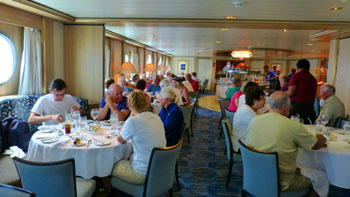 |
 |
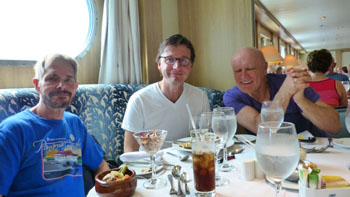 |
After lunch, we went for a walk around the ship, and towards 3PM we were approaching Rabida Island. We took a selection of pictures while we walked around, including two very good close-ups of albatrosses in flight. You can click on the thumbnail images below to see some of these pictures:
 |
As the Xpedition approached Rabida Island, we got a good view of it off the port side. I went up to the observation deck and over to that side of the ship and took a series of four pictures to put together into the panoramic view below:
 |
As the ship continued on, we went back to the cabin to get ready for the next shore excursion.
Galapagos Shore Excursion (2):
A Long Walk and Snorkel on Rabida Island
|
| "This excursion will involve a wet landing and then a walk along a rocky, short but steep trail about one mile long. It can be very hot. Return to the beach for snorkeling or back to the ship. Duration: Approximately 2-3 hours" |
From the Xpedition to Rabida Island
|
 |
Rábida Island is, of course, one of the Galápagos Islands. A British expedition named the island "Jervis Island" in honor of the 18th-century British admiral John Jervis, but in Ecuador it is officially known as Isla Rábida.
The island has a total area of 3 square miles and a maximum altitude of 1000 feet. The island has red sand beaches and a saltwater lagoon inhabited by flamingos and a bachelor sea lion colony. The landscape is studded with small volcanic craters along sharp slopes and cliffs.
In addition to flamingos and the bachelor sea lion colony, pelicans, white-cheeked pintails, boobies, and nine species of finch have been reported.
In 1971 the Equadorian National Park Service successfully eradicated goats from Rábida. This animal, introduced by early visitors to the island, upset the natural environment and led to the extinction of several native creatures including geckos, land iguanas, and rice rats.
On the Beach on Rabida Island
|
We spent some time before the walk just observing the sea lions; click on the thumbnail images below to see us doing so:
 |
And they were fun to watch. Looking at them lying upside down reminded me of the way our cats sleep sometimes, and made me wonder if this is some common behavior across all animals who are not concerned with predators. At one point, a young pup was seen scrambling through the group, apparently trying to find Mom; Fred got a good movie of him. At another point, I made a movie of the sea lions using the camera extender that Fred got me before we left. You can use the players below to watch these movies:
|
A Pup Searches for Its Mom |
Sea Lions on Rabida Island |
Both male and female sea lions have a pointy, whiskered nose and somewhat long, narrow muzzle. The young pups are almost dog-like in profile. Another characteristic that defines the sea lion are their external ear-like pinnae flaps which distinguish them from their close relative with which they are often confused, the seal.
|
When wet, sea lions are a shade of dark brown, but once dry, their color varies greatly. The females tend to be a lighter shade than the males and the pups a chestnut brown. Born with a longer, brownish-black coat, a pup gradually fades to brown within the first five months of life. At this time, they undergo their first molt, resulting in their adult coat. The age of maturity for Galápagos sea lions is estimated at about 4–5 years. The total life span of Galapagos Sea Lions is estimated to be at 15–24 years.
|
To view the slideshow, just click on the image at left and I will open the slideshow in a new window. In the slideshow, you can use the little arrows in the lower corners of each image to move from one to the next, and the index numbers in the upper left of each image will tell you where you are in the series. When you are finished looking at the pictures, just close the popup window.
The Beach to the First Overlook
|
Beginning Our Hike on Rabida Island |
When professionals use these extenders, they eventually edit out the few seconds at the front and back where they usually have to reach over to the camera to start and stop the movie. I have not taken the time to do that with my little movies here; they aren't intended to be professional-quality anyway. And I am just getting the hang of using the extender, and knowing which way to hold it so you can see me and the background. Initially, I tended to hold it too low, and what you will see is a lot of sky in the first movies. But after I reviewed them, I could tell that I should hold the camera more at face level, and I think my later movies will be much better.
The other problem that I have is trying to deal with the noise created when even a gentle breeze flows across the microphone opening- a common problem, according to my Internet research. There is also a simple solution, again according to the Internet. It is to cover the microphone with a piece of dense sponge, which allows normal sounds to be recorded but effectively disperses and mutes the wind noise. (This is why you often see regular microphones with large spongy covers at the mouthpiece end.) After my first day of movies, I tried this solution, but I actually covered the wrong little opening; it was not until much later that I found this out. So, throughout this trip, I found that many otherwise good movies were spoiled by this wind noise interference. My solution for this trip's pages will be to simply eliminate the audio track for movies that I very much want to include but which don't rely on my narrative for you to understand what you are seeing. (When the narrative is essential, I'll go ahead and include the audio track, and apologize in advance for the interference.
|

|
Fred used his camera to make an interesting panorama just as we got to the overlook; you can use the scrollable window below to have a look at it:
At the North Overlook
|

|
Here at the overlook I took a series of five individual pictures to stitch together into a panorama. The lighting was different in different directions, but I have tried to smooth it out. You can use the scrollable window below to see the panorama:
At the East Overlook
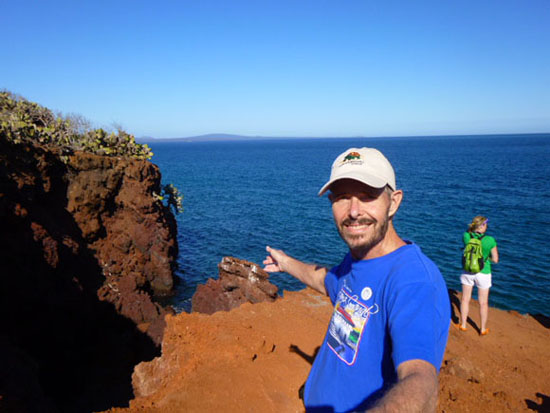 |
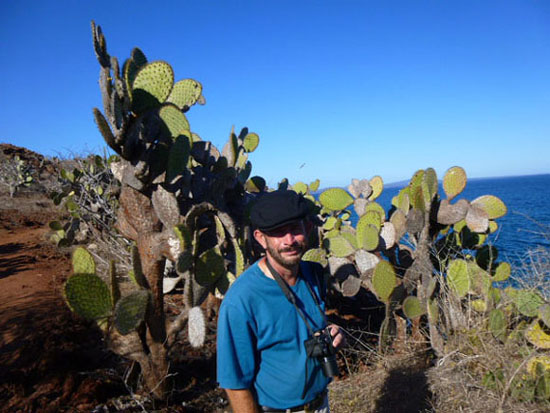 |
Fred and I had been at the north overlook a bit longer than the group, so when we started down after them, we could see them heading down to the shore.
|
While I was focusing on the scenery of the shoreline, Fred had spotted something hidden in the brush that everyone had walked right by. It turned out to be a Galapagos finch.
There was lots to see along the shore here. Of course, the shore itself was quite pretty, but there were also pelicans and low-flying frigate birds, and even some Galapagos penguins swimming through the bay. We took lots of pictures; if you click on the thumbnail images below you can see six of the best of them:
 |
We were enjoying the hike in the bright sunshine, but soon it was time to head back to the beach for the optional snorkeling.
Back to the Beach
|
Though it finds most of its food by searching vegetation, it will hunt insects on the ground and also by flycatcher-like hawking. Second only to the vermilion flycatcher in brightness and colour, the yellow warbler has the sweetest song of Galapagos birds. It nests during the warm/wet season in the canopy of trees and shrubs where it constructs an attractive nest of mosses, lichens and other vegetation.
It was a nice stroll back down the trail, and you can click on the thumbnail images below to see some of the pictures we took along the way:
 |
We got back to the shore where some of our party were going snorkeling. We had been told at lunch that this afternoon's snorkeling would be "deep-water snorkeling". Fred and I assumed that this would be way out from shore, and were a little uncomfortable making that only our second snorkeling opportunity, and so we didn't bring our snorkeling stuff. As it turned out, they only meant that the water would be deeper than this morning, but the actual snorkeling would only be twenty or thirty feet away from the shoreline.
|
We took rather more pictures of the endearing sea lions, many of whom seem not have moved while we had been gone. If you would like to see some more pictures of them, just click on the thumbnail images below:

|
We left Yoost to his snorkeling, and Greg, Fred and I took the next Zodiac back to the ship. On the way, I got a nice photo of Fred in the Zodiac with Rabida Island in the background, and you can see that picture here.
Evening on the Celebrity Xpedition
There was dinner in the dining room, of course, where we either sat the four of us together or, more often, with some or all of the folks that we had come to know (which eventually included two or three other couples).
Each evening, Monica, the cruise director, took us through the activities for the next day, and we had a chance to sign up for whichever of the activities we wanted. For example, tomorrow's stops would be on Isabela Island, where we signed up for a Zodiac ride through the mangroves in the morning and a long walk and Zodiac ride in the afternoon.
Finally, Fred and I would sometimes walk around the ship (which, since it wasn't very big, didn't take long) or go back to the lounge to read.
This pleasant routine continued throughout the week. I suspect that I, myself, consumed the better part of a couple of bottles of Bailey's Irish Cream, in addition to the various daily cocktails. Today's was the "yellow warbler," which was a concoction of rum and various liqueurs- right up my alley.
You can use the links below to continue to another photo album page.
 |
November 11, 2014: Isabela Island |
 |
November 9, 2014: From Quito to the Galapagos |
 |
Return to the Index for Our Galapagos Expedition |